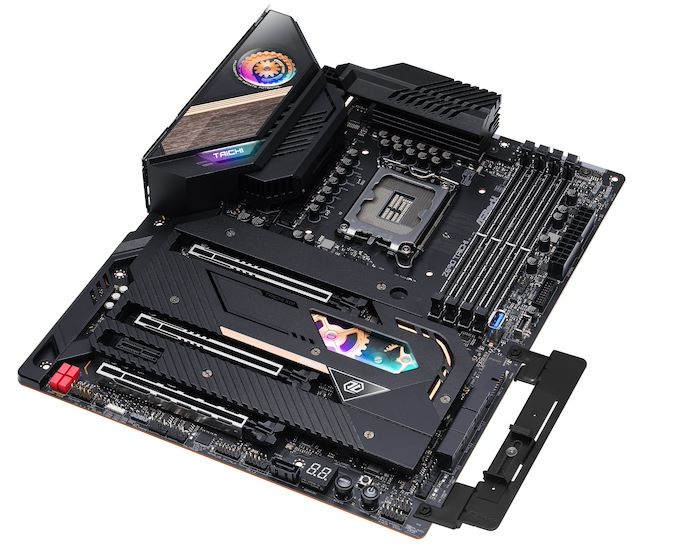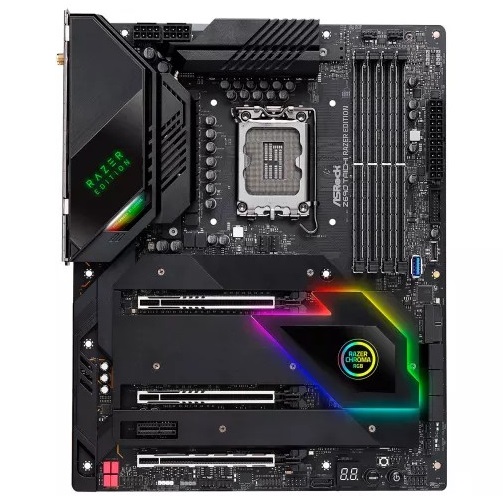The Intel Z690 Motherboard Overview (DDR5): Over 50+ New Models
by Gavin Bonshor on November 9, 2021 9:00 AM ESTASRock Z690 Taichi & Z690 Taichi Razer Edition
Kicking off our Z690 overview in alphabetical order, we'll start with ASRock. ASRock includes its patent-pending ASRock Graphics Card Holder with all of its Z690 models. This is designed to help prevent sagging when used with heavier and long graphics cards.
As it currently stands, the most premium model in ASRock's arsenal for Z690 is from one of its most successful motherboards series, the Taichi. The ASRock Z690 Taichi has a variety of premium features including an advertised 20-phase power delivery with the latest 105 A power stages, as well as a slightly redefined look for 2021. Touching on the design, ASRock includes its mechanical cogwheel effect built into the rear panel cover, which includes RGB LED backlighting, with more RGB built into the cleverly designed cogwheel inspired chipset heatsink.
Looking at the lower portion of the Z690 Taichi, it includes three full-length PCIe slots, including the top two operating at PCIe 5.0 x16 and x8/x8, a third full-length PCIe 4.0 x4 slot, and one PCIe 3.0 x1 slot. Focusing on storage, the ASRock Z690 Taichi includes two PCIe 4.0 x4 M.2 slots, with a third M.2 slot that has support for both PCIe 3.0 x4 and SATA drives. The board also features seven SATA ports in total, with six of these supporting Intel RAID 0, 1, 5, and 10 arrays. Located in the top right-hand corner are four memory slots that can support DDR5-6400, with a combined capacity of up to 128 GB.
The ASRock Z690 Taichi Razer Edition shares the same feature set as the regular Z690 Taichi, but with a Razer-inspired twist. This includes a funky Razer Edition logo on the rear panel cover, with Razer Chroma RGB LED lighting which from the image above, pops really nicely. It drops the cogwheel theme of the Taichi and essentially replaces it with Razer branding.
On the rear panel of the ASRock Z690 Taichi is a pair of Thunderbolt 4 Type-C ports, with two USB 3.2 G2 Type-A, and four USB 3.2 G1 Type-A ports. Onboard audio is handled by a Realtek ALC1220 HD audio codec and ESS Sabre 9218 DAC pairing and consists of five 3.5 mm audio jacks and one S/PDIF optical output. Interestingly, ASRock has put the audio connectors in the middle of the rear panel, as opposed to the end. For networking, ASRock is using a Killer E3100G 2.5 GbE controller, with an additional Intel I219-V Gigabit controller, with a Killer AX1675 Wi-Fi 6E CNVi. Finishing off the rear panel is a single HDMI 2.1 video output and a small BIOS Flashback button.













126 Comments
View All Comments
DigitalFreak - Tuesday, November 9, 2021 - link
Except DirectStorage actually exists in the XBox Series X. Once the XBSX native games start getting ported things will start to move.Bp_968 - Wednesday, November 10, 2021 - link
Why fill my pc with loud and hot hard drives? I have 2 M.2 sticks as local storage and a NAS for all the rust drives in another room. I wouldn't want to go back to the days of using my PC for that.And if you must have tons of sata just buy a SAS card. Their cheap and flexible. Each SAS port on the card fans out to 4 sata ports using a cheap cable.
The Von Matrices - Tuesday, November 9, 2021 - link
Since the 100 series chipsets, the lanes for the SATA ports are shared with other things, so you aren't getting dedicated ports like you used to. You have to disable other features if you want to use all the SATA ports. With my current Z390 board, I can't use more than 2 SATA ports without compromising on other features, and I can't use all 6 SATA ports unless I disable both M.2 slots. Since they're sharing lanes, there's little cost and little reason to not have them, and that will probably continue into the future.DigitalFreak - Tuesday, November 9, 2021 - link
Things have changed the last couple of generations. My Z690 board has 6 SATA ports and 4 PCIe 4.0 x4 M.2 slots. The only thing shared is SATA between one SATA port and one of the M.2 slots. As long as you don't need a M.2 SATA drive, you can run 4 NVMe drives and 6 SATA devices simultaneously..KarlKastor - Wednesday, November 10, 2021 - link
There has nothing changed. The IO-Lanes of the chipset can eather be SATA or PCIe. The reason why you have nothing shared is, because they saved money for switches. You have not the option how to use this Lanes.This happens since Rocket Lake. The CPU has additional PCIe lanes, so you don't need to share much anymore and the Board is full already. There is no space for more M.2. Backside maybe.
12345 - Monday, November 15, 2021 - link
Z690 has a x8 gen 4 link to the chipset now. You don't have to disable SATA anymore to use all m.2 slots.meacupla - Tuesday, November 9, 2021 - link
I am pretty sure intel had 8 SATA ports since Z77, but board manufacturers routed 2 SATA ports for m.2 SATA. The On Z87 and Z97, 8 SATA ports with 2 ports shared for m.2 SATA was totally a thing.KarlKastor - Wednesday, November 10, 2021 - link
The silicon has 8 ports for long time. But maximum usable for the Zxy7 was 6. Eight were workstation only.If you used shared SATA on M.2, then you had less than six SATA Ports usable.
TheinsanegamerN - Tuesday, November 9, 2021 - link
SATA SSD sales continue to remain strong, and are much mroe economical for large file storage per TB then M.2 drives (a 2TB SATA drive is around $170 now), and if you have a RAID aray with 3+ drives speeds begin to encroah on NVMe speeds, a RAID 5 array with 4 SATA III will hit 1.6GB/s read speeds.Mr Perfect - Tuesday, November 9, 2021 - link
Man, these Z-chipset boards keep going up in price. I'm curious what eventual H670 chipset boards will look like. If they've got everything you need without all the flashy bits, I'll probably shoot for one of those.